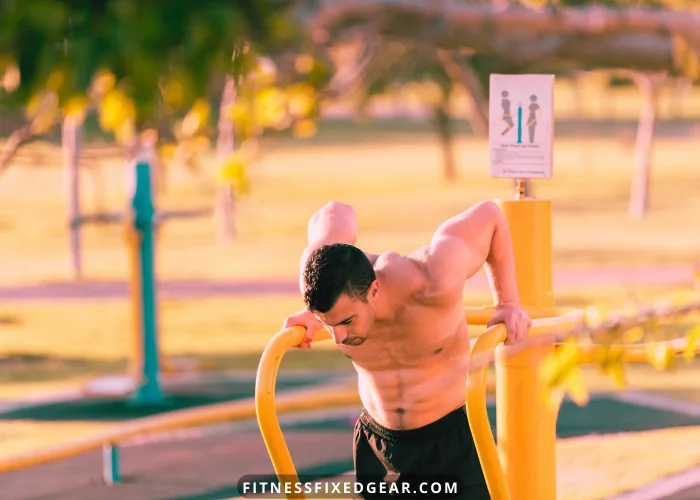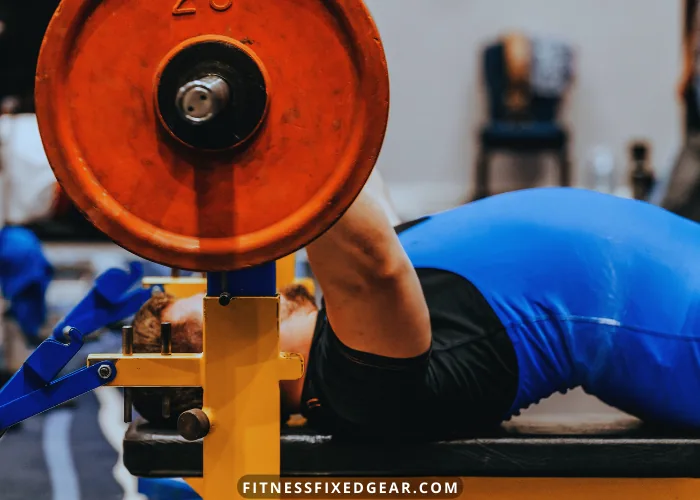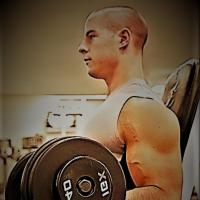Chest dips are an excellent bodyweight exercise that targets your chest muscles plus hits your triceps and anterior deltoids (more on this later).
But what if you don't have a set of parallel bars or simply want to shake up your chest workout routine?
Enter the 13 best alternative exercises for chest dips! Let's dig in.
What Are Chest Dips?

Just in case you're asking yourself what in the heck is a chest dip.
This move is an upper body workout designed to target muscles like your pecs. Dips are a great place to start if you're looking to build upper body strength with very little equipment.
Here's how you do them:
- Begin between parallel bars, starting in a lifted position with elbows locked and your body weight supported by your arms.
- Lean forward slightly to target your pectoral muscles (more than your tricep muscles). Then, slowly lower yourself down until your upper arms are roughly parallel with the bars.
- Press yourself back to starting position.
Boom, you've just done a chest dip.
TL;DR: A chest dip is when you use parallel bars to lower yourself down and back up, leaning forward slightly. Weighted chest dips add an extra element of difficulty.
What Muscles Do Chest Dips Work?
The Chest Dip Exercise works these muscles:
- Pectoralis Major
- Triceps
- Anterior Deltoid
Lean forward more to target those pecs, or lean back to target those triceps. It all depends on your goal for the exercise.
Also, if you need tricep dip alternatives, we've got you covered here: 14 Powerful Tricep Dip Alternatives.
TL;DR: Chest dips work primarily on your pectoralis muscles if you maintain a forward lean.
What Makes a Good Chest Dip Alternative?

Great dip alternatives will do two things:
- Target similar muscle groups as the dip.
- Strengthen the pressing ability of the chest and triceps.
The second one is key if you're looking to boost your bench press, overhead press, or jerk.
TL;DR: Effective alternative exercises work the same muscle groups and boost your overall lifting power.
12 Best Chest Dip Alternatives
Now we get to the crux of it: if you can't do a parallel bar dip or have access to bars, here are 13 other exercises to try.
1. Diamond Push-Ups
A diamond push-up is a body weight movement that will kill your chest muscles for sure. These are similar to traditional push-ups, except your hands form a diamond shape instead of being slightly wider than shoulder-width.
It's important to note if you can't do regular push-ups yet, don't try diamond ones. These are more challenging, so save them for once you've mastered traditional push-ups.
Equipment Needed:
- None (but can add resistance bands if It's too easy for ya)
How To:
- Begin on your hands and knees. Instead of placing your hands slightly wider than shoulder-width, bring them together directly under your chest. Your pointer fingers and thumbs should touch in the diamond shape.
- Extend your legs straight back into a plank position. Keep your core engaged, your entire body tight, and your spine neutral. You should form a straight line from your head to your heels.
- Breathe in and lower yourself toward the floor. Keep your elbows tucked so they don't flare.
- Breathe out and push back up. Move your entire body as a unit and keep all your muscles engaged throughout.
Pro Tip:
To build the strength to tackle not only regular push-ups but diamond ones, start in an elevated position with your hands braced on something tall, like a sturdy table or windowsill. Then gradually lower your hands as you build strength until you're pressing from the floor.
2. Close Grip Bench Presses
A close grip bench press increases the range of motion of your press, meaning you get more "bang for your buck" in each lift.
Plus, it's a great alternative if you have a previous shoulder injury or strained shoulder muscles. Reducing the grip width creates less shoulder abduction and places less stress on the shoulder joint.
Equipment Needed:
- Dumbbells or a barbell
- Flat bench/Olympic Weight Bench/Power rack (or from the ground) and
How To:
- Lay on a flat bench with the bar positioned above you or braced on your chest. Grip the bar with your hands directly above your shoulders (not wider, not too close).
- Keep your feet flat on the ground. Brace through your core and engage your legs. Make sure your flat bench is steady.
- Lift the bar off the hooks. Inhale as you slowly lower the bar toward your chest, keeping your elbows slightly tucked. (Or, exhale to press the bar to starting position, then follow the inhale-lower step.)
- Exhale as you press the bar back overhead.
Pro Tip:
If this type of chest press is old hat for you, try lowering the weight more slowly to increase your time under tension.
3. Decline Bench Presses
A decline bench press is done on a flat bench but with the upper part of the bench on a decline (or you can use a specific decline bench).
Lowering the bench means this type of chest press targets your upper chest a bit more. If you're a pro at traditional presses already, try doing a decline bench press next time instead.
Equipment Needed:
How To:
- (We'll use dumbbells for this one because the above press used a barbell.) Hook your feet under the end of a decline bench. Holding your dumbbells, lie back on the bench. Raise the bells into pressing position (palms facing away from you, hands in line with your shoulders).
- Inhale and lower the weights until your elbows are at about a 90º angle. Your forearms should always be perpendicular to the floor.
- Exhale and press the bells back up to starting position.
Pro Tip:
This movement pattern is another one that's easy on your shoulder joint while making an excellent alternative to chest dips.
4. Band Chest Flys
This chest exercise targets the same muscles as chest dips but with equipment that's usually more accessible (or at least easier to store).
Equipment Needed:
How To:
- Attach your resistance band or bands to a stable surface about chest height. You can use a door frame, a power rack, your car, a wall mount... you get the idea. You need to hold a resistance band in each hand, so attach two or get creative with looping your single band.
- Take a few steps away from the attachment point, so there's a little tension in the band and a slight bend in your elbows. Take a split stance with one leg in front of the other. This is your starting position.
- Exhale as you maintain that slight bend in your elbows and bring your hands forward in front of your chest. Keep your core tight, a gentle bend in your knees, and a neutral spine.
- Inhale as you slowly let the band back to starting position. Don't just release the band and let momentum do the work! Make sure it's a controlled movement.
Pro Tip:
Adjust where you anchor the band to target different areas of your chest. A lower anchor point creates an incline to target your upper chest, mid-anchor targets your mid-chest, and a higher anchor targets your lower chest muscles.
5. Pec Flys
This move needs a pec deck machine, but it's such an excellent alternative to chest dips that really zeroes in on those chest muscles that we had to include it. The "how-to" is only going to include the set up because after that, it's the exact same as banded chest flys.
Equipment Needed:
How To:
- Choose an appropriate weight for your strength level and adjust the seat, so your arms are parallel to your chest.
- Sit down with your back pressed firmly into the seat back. Keep your shoulders down away from your ears and your feet flat on the floor. Brace your core.
- Follow the steps for a band chest fly.
6. Bench Dips
If you don't have access to dip bars or a dip machine, you can perform dips off a flat bench. This move will work your chest and triceps and is similar to tricep dips, but the key is in your hand position.
Don't grip the edge of the bench with your fingers and thumbs forward. This is really hard on your shoulders (see the video for a good example of this).
Instead, rotate your hands outward so your shoulders pull out and your shoulder blades are more contracted.
Equipment Needed:
How To:
- Approach the bench and make sure it hits just below your shoulder blades. Sit down in front of it with feet slightly ahead of your hips. Place your hands with fingers turned out on the bench beside you.
- Lift yourself up, so your body weight is supported on your hands. Make sure your shoulders aren't rounded forward or scrunched up to your ears (also helps avoid neck pain). This is your starting position.
- Inhale as you lower yourself into the dip. Exhale to push yourself back up.
Pro Tip:
This move is heavy on the upper arms, so make sure you're strong before you try adding weight.
7. Barbell Dips
Another great option if you don't have a dip machine is to use a barbell instead. This dip exercise is similar to doing a pull-up, except your pushing yourself up and down on a barbell. Check out the video for a visual.
Equipment Needed:
- Barbell and power rack (or something else secure to brace the bell on)
- Playground equipment bars
How To:
- Approach the bar at about upper chest height. Step or jump up, so you're supporting your body with arms fully extended and with an overhand grip. Maintain a tightness throughout your entire body, similar to when doing pull-ups. Your body should make a gentle curved shape with tension throughout.
- Inhale as you lower your body toward the bar until your chest barely touches it. Exhale to press yourself back up to arms extended.
Pro Tip:
This isn't exactly a beginner-friendly exercise, so if you're building strength, try standing in a resistance band to help you out.
8. Close-Grip Push-Ups
Similar to the diamond version, a close-grip push-up really targets your pectoralis muscles and is great for your upper body strength, including those triceps.
Equipment Needed:
- None, but you can place a weight plate on your back for an extra challenge
How To:
- Get in the standard push-up position (hands flat, legs back in a tight plank, etc.).
- Instead of having your hands wider than your shoulders, place them directly beneath.
- Inhale and lower yourself toward the floor, keeping your elbows glued to your torso. You should almost feel your upper arm grazing your sides as you lower and lift.
- Exhale as you press back to starting position.
Pro Tip:
This is another push-up that's better for advanced lifters. Make sure your traditional push-up form is solid before attempting these.
9. Dumbbell Hex Presses
The dumbbell hex press targets more of your inner chest and requires more stabilizer muscles, making it an efficient way to work your pecs. Don't be fooled by how "easy" this dumbbell press looks — it's a killer chest workout.
Equipment Needed:
How To:
- Lay back on your bench and (if necessary) kick each dumbbell up, so you're in a position like you're going to do a chest fly or bench press (overhand grip).
- Then, press the dumbbells together over your chest, arms extended. Keeping pressure on the bells, so you're pressing them together, inhale as you lower them toward your chest (don't rest them at the lowest point).
- Exhale to press the bells back up.
Pro Tip:
Really squeeze the bells together in this dumbbell press to zero in on your chest muscles.
10. Cable Chest Flys
If you've got a cable machine handy, this machine-based exercise is killer on those pecs. It's similar to a banded chest fly, except using a machine so you can up the weight.
We also have this cable crossover alternatives list for a complete upper body workout.
Equipment Needed:
How To:
- Place the pulley of your cable machine about chest level. Grasp each handle and step forward, staying in a straight line in front of the cable machine.
- Keep a small bend forward at your waist and bring the pulleys out in front of you. This is your starting position.
- Keep a gentle bend in your elbows, then breathe in and extend your arms backward until you feel a stretch in your chest. Don't just let the weights fall down on the machine.
- Exhale as you press to extend the pulleys forward, back to the start.
Pro Tip:
Adjusting the set point of the pulleys can work different parts of your chest in different ways, similar to a banded chest fly.
11. Plate Pinch Press
This is another move that's deceptively simple yet super challenging for your upper body. It also places a minimal load on your shoulder joint, making it a safe alternative for folks with previous injuries.
Equipment Needed:
- Two 5 or 10-pound weight plates (or some other flat, weighted object you can hold between your palms)
How To:
- Align the plates and press them between your open palms. Keeping constant pressure, exhale as you press your hands out.
- When your elbows are extended and arms straight, inhale to bring the plates back to your chest/torso.
Pro Tip:
Like dumbbell hex presses, the plate pinch press only works if you're really squeezing your hands together during the move.
12. Bench Presses
We've covered the close grip and decline press, so now it's time to finish with the tried-and true chest exercise: the bench press.
Equipment Needed:
How To:
- Follow the same steps as for the close-grip press, except your hands will be slightly wider than shoulder-width.
Pro Tip:
If you don't have dumbbells or a barbell, you can use a resistance band or even try a straps chest press. It has a similar range of motion, so it'll work as an excellent substitution for weights.
Conclusion
These dip exercises alternatives will not only help you get bigger and more defined pectoral muscles, but they will also help you improve your pressing ability, which in turn, help you even more in boosting your pecs and upper body strength.

